Royal IC-130
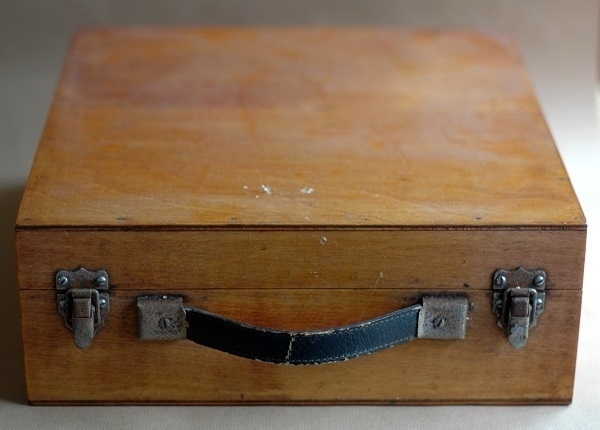
An item I’d ordered from an ebay seller arrived in a sturdy wooden case with metal catches and a leather handle. The case gives the appearance of having been custom-made for its contents. It’s about the right size and shape to have contained a compact mid-20th Century typewriter, and, as it happens, the object within carries a “Royal” badge, Royal having been a major American typewriter manufacturer. Inside the case are several precisely-shaped and carefully-positioned pieces of foam rubber to cradle its contents, not a typewriter but a different kind of office machine: a calculator.

While the “Royal” badge is on the front of the machine, elsewhere it’s marked “Imperial Typewriter Company, Leicester, United Kingdom”. This isn’t altogether a contradiction, as, by the time this calculator was made (ca. 1972), both the Royal and Imperial brands had been absorbed by the same parent company: Litton Industries. Although there’s no mention of it anywhere on the device, the Royal IC-130 would have been manufactured in Japan, rather than the US or UK.

Its green VFD display dates back to a point in time when the problem of selectively un-illuminating individual digits hadn’t yet been solved. As a workaround, unused leading digit positions always contained a zero – which, as in some other calculators of similar vintage, was displayed half-height relative to the other numerals. The calculator is in sporadically working order. The switch setting the number of decimal places to be displayed is sometimes respected, sometimes not. And it may take a few attempts to goad a correct result from its elderly electronics.
Song Book
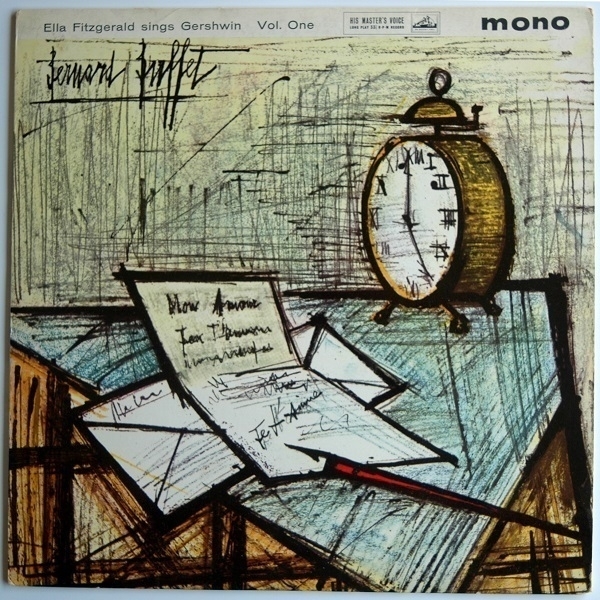
When I saw the LP copy shown above of Ella Fitzgerald Sings the George and Ira Gershwin Song Book (vol. 1), on sale for a few pounds the other week, I wasn’t sure if I should buy it. Why did I hesitate, when George Gershwin was the first composer of that style & of that era whose music I’d taken a shine to (after I’d acquired a two-CD ‘Best Of’ compilation of his music back in my late twenties)? And when I was already in possession of vinyl copies of Ella singing the Cole Porter, Rodgers & Hart, Duke Ellington, Irving Berlin, Harold Arlen, Jerome Kern and Johnny Mercer Song Book albums (though only vol.2 of the Ellington one)?
The Gershwin Song Book holds the distinction of being the most voluminous of the series, running to five LPs in total. I’d never encountered the complete set in the wild, and hardly ever any of its separately issued volumes. I had, however, heard the whole thing on a CD re-issue, and had been disconcerted to find I didn’t warm to it, for all my prior enthusiasm for the singer & the composer. It proved to be just a little too much Gershwin for my liking; with a few too many deep cuts mixed in with the big hits. A double LP selection would probably have been a better fit for me. Even so, I did buy the record in the picture.
First issued by Verve in 1959, my British-pressed mono copy has a “His Master’s Voice” label. When I played it, my reaction – alas – was no different than when I’d heard the songs on CD. I do very much like the sleeve-design though, and may yet keep it just for decorative purposes. It’s one of five paintings by the French artist Bernard Buffet that were used for the sleeves of the five discs on the original set.
Jin Jun Mei
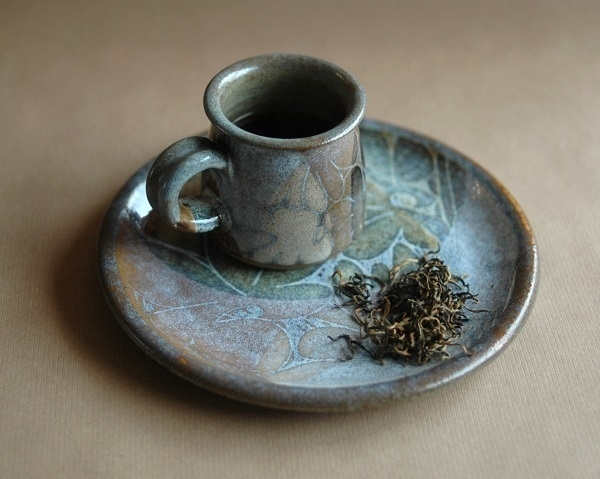
A highlight of my last order of loose-leaf teas from What Cha is the Jin Jun Mei black tea from Fujian province in China. They describe it as “a smooth tea with a sweet malt loaf taste with floral rose hints in the background”. While the floral notes weren’t obvious to me, the maltiness and sweetness definitely were. It put me in mind of bara brith. I very much like it, but at a steep £16 for 50g, it’s never going to be an everyday drink.
The cup and the plate in the picture above were apparently made by Diana Worthy at Crich Pottery in Derbyshire. I bought them at the local charity shop a couple of weeks ago.
Three Candlesticks
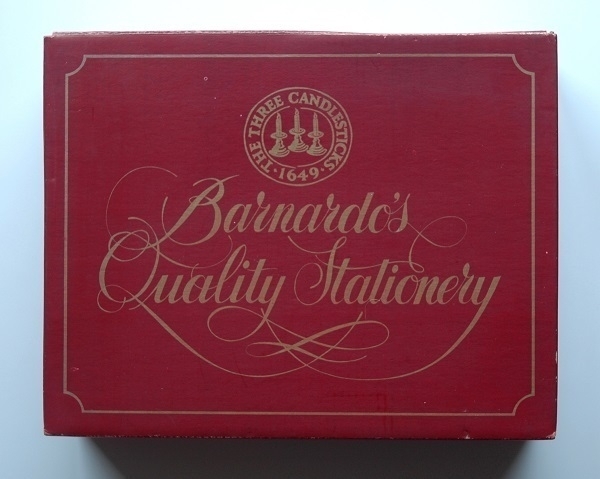
Pictured above is a recently-acquired part-used box of paper & envelopes as originally supplied by Barnardo’s Quality Stationery. I’d guess this has to do with the Barnardo’s charity, but for all I know it may be an unrelated retailer’s name. Also on the lid of the box is a logo with the text ‘Three Candlesticks 1649’: this was one of the brands used by John Dickinson & Co. The logo doubles as the paper’s watermark.
According to this page, “The need for up-market writing sets, attractively boxed in faux leather cases, brought the Three Candlesticks range to market.” I’m not sure how far it dates back – not to 1649 – but it was certainly around a century ago, at which time it was described as “a tub-sized pure rag parchment wove paper”. The brand-name supposedly relates to a coin token found on the site of the company’s first London offices, which would likely have been issued by a tavern of that name.

This box & its contents probably date back at least a few decades. The paper is post quarto (9" x 7") in a cream colour. The envelopes are lined with brown tissue. I first bought some Three Candlesticks back in the ’90s, and am happy to know it’s still being made today. I already had some of the stuff hiding in a box with a different brand-name.
Ringtones

I was reminded of an obsolete form of ephemera last week when I opened up a second-hand CD I’d ordered via Discogs – a copy of Erykah Badu’s awkwardly-titled 2007 album New Amerykah: Part One (4th World War). Inside it was a slip of paper advertising mobile phone ringtones based on some of the album’s tracks, and, on the reverse of the slip (shown above), others based on songs from Badu’s back-catalogue. The kinds of music I was buying ca. 2007 didn’t often overlap with the market for ringtones, but I’d certainly seen (and immediately discarded) a few such slips by then.
2007 of course was the beginning of the smartphone era. CD sales had already been declining for a few years, illegal file-sharing was rife, and the advent of streaming services was on the horizon. Meanwhile, the vinyl revival was in its early stages: by 2017, instead of ringtone slips falling out of one’s new CDs, download code slips were falling out of one’s new LPs.
Mina's Matchbox

My eye was drawn to a copy of Mina’s Matchbox on a shelf at Chepstow Books and Gifts during my last visit there. It’s the latest novel by Yōko Ogawa to appear in English. My first taste of this author’s work was her collection of ingeniously-interlinked short stories Revenge, which still remains my favorite book of hers. I was less impressed by the last of Ogawa’s books I’d sampled – The Memory Police – which had given me the impression of a thought-experiment left to run on for too long. My naive impression had been of an enjoyable earlier work and a weaker later one, but of course translations don’t always appear in the same order as their originals, and I’ve just now realised that Revenge was published four years later than The Memory Police in Japan.
As for Mina’s Matchbox, I liked it. I found it charmingly sweet, but not cloyingly so; and relatively light without being insubstantial. In tone it resembled The Housekeeper and the Professor more than Ogawa’s other works in English.
In 1972, twelve year-old Tomoko leaves home to spend a year living with her aunt’s family, while her widowed mother completes a course in Tokyo. The aunt had married a wealthy businessman, and they were living in fine and somewhat eccentric style in a substantial country house with their fragile, asthmatic daughter (the titular Mina), the uncle’s German mother, their two servants, and a highly-unusual pet. Tomoko is warmly accepted by the family and she and Mina become very close. I’d half-expected some kind of intense drama to intrude before the end, but the story is lower-key than that, more a slice of (unconventional) life. It’s a well-paced, characterful and easy-to-read novel with enough depth to lend it some satisying emotional weight.
Reclamation

While the shot above isn’t an ideal composition, I’m fond of it anyway. It depicts the way leading off the Gloucester Road in Horfield, Bristol, toward the entrance of Reclaimers Reclamation who “specialize in bespoke handmade kitchens and furniture created from reclaimed timber and glass”. It was (and probably still is) an intriguing place to look around, though I never bought anything there. I recall being tempted by a pre-WWII Continental portable typewriter they had at one time, but the price was too steep for my liking.
The main problem with the photo, to my eye, is the poster on the right-hand side being partly out of frame. A wider-angle lens would have helped with that, but the camera I had with me that day was my Yashica Mat, with no option to change the focal length. Taking in more of the poster would have made the two statues further off-centre – having them roughly symmetrical seemed more desirable. Had I taken a step or two further back, it would have introduced more unwanted elements into the frame and I’d have probably ended up cropping the image.
The Yashica was loaded with Kodax Tri-X 400. I can’t remember if I developed it myself or not. If so, I would have used Kodak’s XTOL developer.
Six Scarves
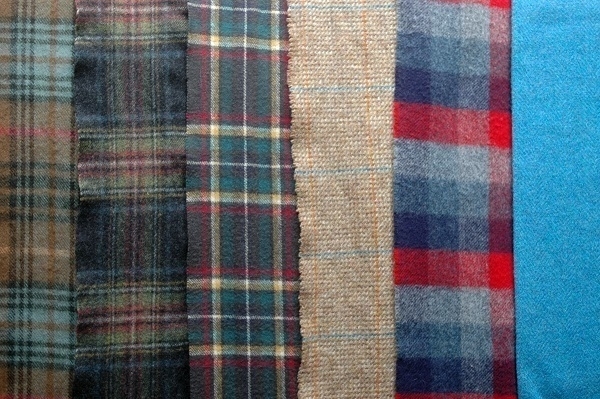
It’s not quite the season for scarves yet, but that won’t be long in coming. I’ve accumulated rather more of the things than I need. As well as the six shown in the picture, another four are out of the frame. All but one of the six are second-hand, acquired at charity shops in recent years. Only the third one from the left was bought new: it’s a Joules scarf I’ve had for about sixeen years.
The defunct retailer Dunn & Co. supplied the leftmost one to its first buyer, while the second from left is a lambswool number originally sold by Johnstons of Elgin. The fourth scarf was made from Shetland wool by Lochcarron (“the world’s leading manufacturer of tartan”). Second from the right is my favourite of the set, the red and grey Barbour one. The blue scarf on the far right is Harris Tweed on one side and silk on the other, in a design by ‘Rarebird’. I bought it in spring when the weather was already warming up, so I’ve yet to give it an outing.
The Black Keys

While I can’t say that The Black Keys' music entirely passed me by, I paid scant attention to it until recently. I’d certainly heard ‘Lonely Boy’ around the time of its release; likewise their collaboration with RZA – ‘The Baddest Man Alive’. I was slightly familiar with their style and sound, and liked what I’d heard. It’s just that their mainstream breakthrough happened to coincide with a time when I wasn’t buying much music, and any subsequent curiosity of mine about them was never quite strong enough that I felt impelled to act upon it.
Last month in a Chepstow charity shop I saw a copy of El Camino on CD priced at 50p. My curiosity was still pretty weak, but the barrier imposed by the asking price was so low that it won out. I very much enjoyed the album, and at last got to hear ‘Lonely Boy’ in its original setting. No more than a couple of weeks later I spotted their previous album Brothers at another charity shop – also 50p. I liked that one even better, especially the likes of ‘Sinister Kid’ and ‘Unknown Brother’. I don’t listen to much rock’n’roll these days, but when I do this sort of thing fits the bill nicely.
At this point in my life the primary role for music is to help me wind down late in the evening before I go to bed. Secondarily, I like there to be music when I’m driving, and this is the setting into which The Black Keys' music will typically fit. Anything that doesn’t work in these contexts seldom gets a hearing, no matter how much I like it in the abstract. Many people will have upbeat music on hand for dancing, running or working out, which aren’t activities I partake in. Some will put on uplifting music to help them negotiate onerous household chores – I prefer angry silence. Others want something ambient playing while they read or write, whereas that seldom works for me.
Bara Planc
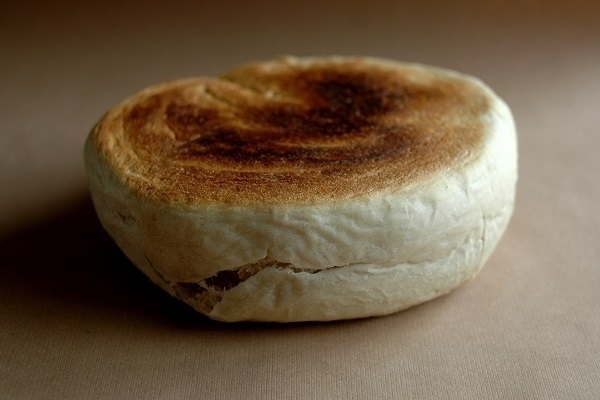
In the picture is the loaf of bara planc (bakestone bread) I made last weekend. It’s something I make fairly often. I follow a recipe I found in Annette Yates’s book Welsh Heritage Food & Cooking (Lorenz Books, 2011). My ingredients were:
- 1 sachet (or 1.5 tsp) ‘easy bake’ yeast.
- 500g plain white flour
- 1 tsp salt
- 1 tsp sugar
- 15g butter
- about 150ml milk and 150ml water
When I say I follow the recipe, I do take some liberties. Rather than work the dough by hand I take a lazy approach and use a bread machine to do that for me. I put the yeast, flour, salt and sugar into the bread machine pan then cut the butter into small pieces and add that. Next I add the milk and water (the exact amount of fluid needed will depend on the flour – if working the dough by hand one could make adjustments, otherwise some trial and error is necessary – lately I’ve been using a little less than 290ml in total rather then 300ml). I sometimes use spelt flour rather than wheat flour, or a mixture of the two. My rather old bread machine has a ‘croissant’ program which takes 2h 20m to make a dough that works well for this bread.
At least half an hour before the dough is ready, I start warming up the bakestone on a medium heat. A cast iron pan can be used if there’s no bakestone or equivalent to hand – such a pan, being thinner, won’t need so long to get to the right sort of temperature. When the bread machine beeps I take the dough out of its pan and put it on the hot bakestone, slapping it into a more rounded shape if need be. After twenty minutes I turn it over and cook on the other side for twenty minutes more. Then it comes off the bakestone and cools on a wire rack. The result is a drum-shaped loaf scorched top & bottom with a soft, pale rim. Inside there’s a ‘seam’ across the middle. It tastes delicious when served very fresh just with butter, or dipped in some baked camembert.
Asylum

Above is another from the set of film-still slides I’ve mentioned a few times before (most recently here). This one comes from an obscurer source then the others I’ve highlighted so far: a 1949 production entitled Asylrecht (‘Asylum’), directed by Rudolf Warner Kipp. IMDB has a description of it, courtesy of the Harvard Film Archive:
Asylrecht is a curious production: medium-length, an unclassifiable cross between documentary and fiction, made on order of the British Film Section, premiered at the Venice Film Festival, shown for the first time in West Germany on the occasion of a refugee congress, and never regularly released except by way of non-commercial distribution for decades in various versions. Call it a crypto classic, like several other works of Rudolf Werner Kipp, a master of educational filmmaking who, in his finest achievements, did honor to his professed main inspiration: John Grierson.
Kipp filmed with real refugees in actual camps. While in many cases scenes were arranged with their participation, some of the most dramatic moments were shot using a hidden camera. The refugees whose plights we learn about here mainly try to leave the Soviet-occupied areas for the Trizone, but not everybody could enter…
Which suggests that the woman in the image wasn’t an actor. I’ve yet to find any footage from the film on-line.
The Leopard

Last night I finished Giuseppe di Lampedusa’s novel The Leopard. It’s a book I’d been meaning to read for years. I never advanced beyond the opening few pages of the copy I bought in Italy ca. 1996, which didn’t then accompany me back to the UK. A similar fate befell a second copy, obtained about a decade later. I hoped for a case of ‘third time lucky’ when I found the volume pictured above at Stephen’s booksop in Monmouth earlier this year. It’s from a 1961 book club edition, and cost me about a fiver.
After breezing through the opening chapter I felt like the time might at last be right to enjoy the novel. Then, however, I became becalmed in Chapter II, and my attention wandered on to other things. Would the third time be so lucky after all? The Leopard has been described as ‘a perfect novel’. Thankfully it isn’t, but it does offer many pleasures: rich & fragrant prose; unexpected and delightful turns of phrase; acute psychological insight – and so on. Somehow though, no matter how much I savoured the text, after putting the book down I would feel scant appetite to pick it back up again.
Having summoned the requisite willpower over the past few days I was amply rewarded on reaching the end. It is an excellent book, and one better appreciated, I suspect, in middle age than in youth – so perhaps it’s just as well my path toward it was such a lengthy & indirect one.
In the Fog

It’s the “season of mists and mellow fruitfulness” again so here we have a couple of autumnal photographs taken in the fog, both captured in Karlskrona, Sweden, on the same October day in 2008. Above is a view of some houses at the tip of a small island barely visible throgh the murk. It’s a digital shot, taken using a Nikon D80, with a 24mm lens attached. The vantage point was Gamla Långöbron (‘The Old Long Island Bridge’) and the subject was the islet of Lilla Pantarholmen.
The fog was a little less dense when I took the shot below in Hoglands Park. This one was taken with my Yashica Mat loaded with Kodak Portra 400 VC film.
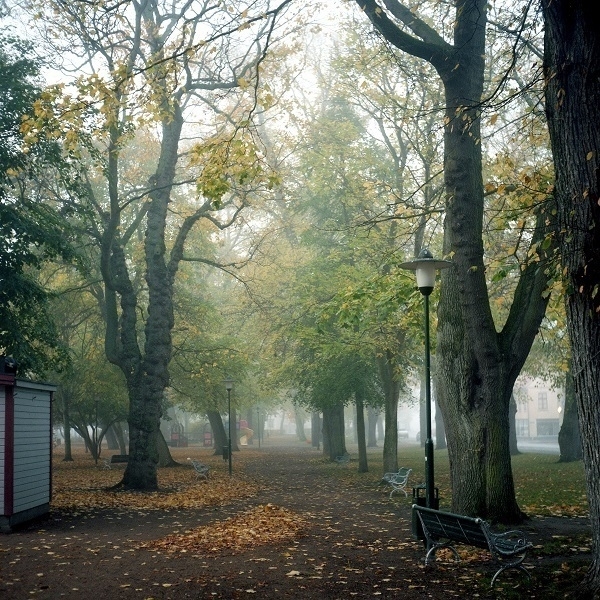
Global

Pictured above are four of the Global-brand stainless steel kitchen knives I bought about twenty years ago. I originally had eight, of which six remain – one got mislaid and another one broke. I also have a knife-block and a sharpening steel to match. I don’t recall know much they cost exactly, but they were certainly expensive. They have lasted a good long while, at least. My best intentions of looking after them and maintaining them properly went all to hell in fairly short order. Since then they’ve been treated with regrettably little respect, hence the signs of pitting and corrosion. They’re also quite blunt, and have been quite blunt for quite some time. I really ought to see if I can get them sharpened, as there should be some life left in them yet.
Solid Air
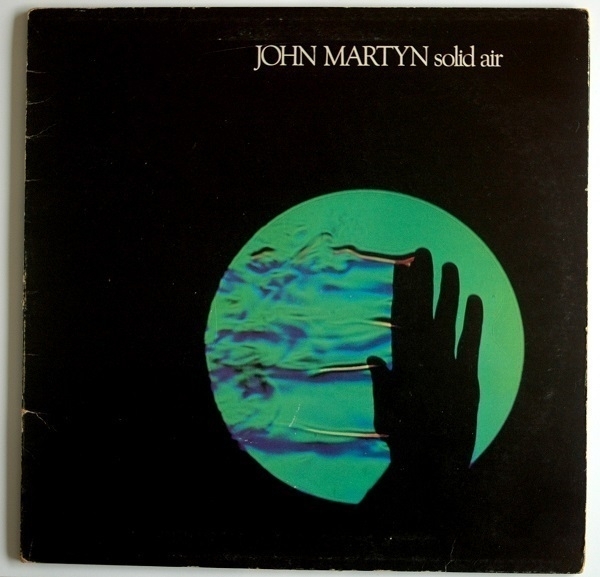
Out of the latest batch of old records I brought back from Chepstow (a few weeks ago), I was especially pleased to have found a copy of John Martyn’s 1973 album Solid Air, a well-regarded record that has made its way on to a few all-time best-of lists. I’d quite often heard the songs ‘May You Never’ & ‘Over the Hill’ and was also acquainted with the title-track, whereas the other six numbers were unfamiliar territory. The copy I picked up, moreover, was from an early pressing with the ‘pink rim’ Island Records label. It would have been worth a lot more than I paid for it, had it not been in such poor condition.
While the sleeve was still in decent shape, the disc, unprotected by an inner sleeve, had picked up a dense tracery of scratches. On giving it a spin there was hardly a moment without a pop or a crackle, yet somehow none of the damage was deep enough to make the stylus skip. I greatly enjoyed the music but knew that all the surface noise would be an impediment to my future listening pleasure. I resolved to buy another copy, opting for the 2013 repress – which had the benefit of reproducing the original label design. When the new record arrived I put the unblemished disc into the old sleeve and discarded the scratched one, an arrangement which suits me even if it confuses or annoys whoever ultimately inherits my records.

Xinomavro
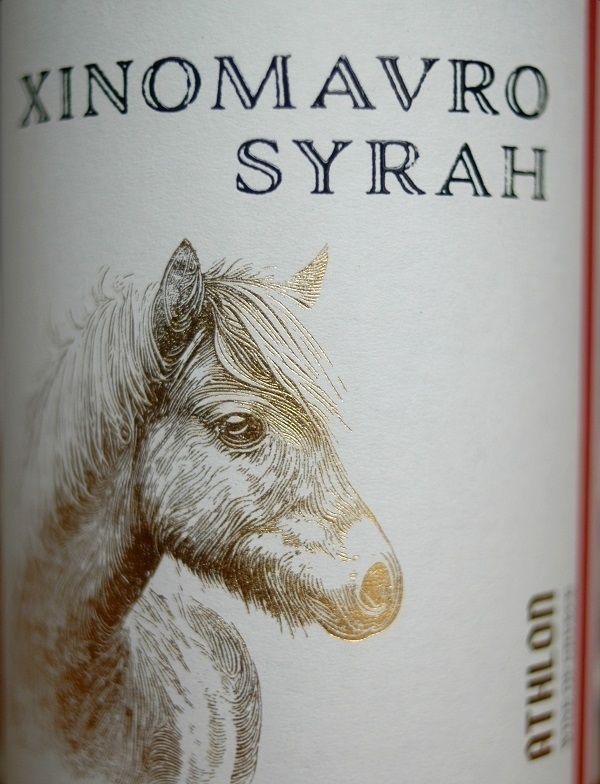
This evening’s bottle of wine is some Greek ‘Athlon Xinomavro Syrah’ (2022). While Syrah is a long-standing favourite, I can’t recall having tried a Xinomavro-based wine before. I’ve learned it’s a variety native to northern Greece. The name apparently means ‘acid black’, which doesn’t seem especially promising, but, according to the wikipedia article, “good examples age well due to the wine’s high acidity and tannin content”.
I picked the bottle up at the local Aldi. The label on the back promises notes of strawberry, cherry, plum and cranberry; along with hints of lavender, thyme and black pepper. For me, sour fruit flavours were immediately in evidence, with their sharp edges rounded somewhat by a warmly tannic savouriness. One reviewer reckoned it a wine that could further improve after another year or two in the cellar – which struck me as plausible, but that’s never going to happen in this house.
Instruction Manual

I’ve mentioned in passing my unwise purchase of a photographic enlarger. Specifically it is an LPL C6700, capable of enlarging from colour negatives as well as black and white ones; and able to handle 35mm and 120 film (up to 6x7) alike. It was far from cheap, setting me back something in the region of £700-800 in 2008 money. It was supplied without an enlarging lens – I afterwards bought not one but two of those as well. And I’ve used the thing three times.
Not only has it stood idle, but it’s an ungainly, bulky white elephant for which I don’t even have a suitable storage space. So it perches awkwardly on top of a chest of drawers, draped in its dust-cover (the one part of it that has served its purpose) as an on-going reminder of my occasional tendency to over-reach and get a bit carried away acquiring things I don’t end up using. The cover of the enlarger’s instruction manual, which I have dutifully retained, is shown above.
Shelf Portrait No. 9

Completing my survey of the downstairs bookcase, here’s the second shelf from the bottom. It’s a work-in-progress with only eight volumes currently on display. I was aiming for a shelf of decorative un-jacketed reference-books, and this is how it’s worked out so far. All but one of these are relatively recent acquisitions, though I’ve owned other copies of The Art Book and The Oxford Companion to English Literature in the past. My prior copy of the former got left behind in a house-move; whereas I’d previously had a fourth edition volume of the latter, now replaced by one from the fifth edition in a garish red fake-leather binding.
To join the The Oxford Companion to English Literature I bought the Companions for Wine and for Cheese. thereby covering three major sources of nourishment. To go with the Phaidon Art Book (a cheap charity-shop find), I ordered a matching copy of The Photography Book via ebay. The other three volumes are Leonard Feather’s & Ira Gitler’s The Biographical Encyclopedia of Jazz, The Grammar of Spice by Caz Hildebrand, and The Encyclopaedia of Type Faces by W. Pincus Jaspert et al. in a late ’50s edition.
Escapism

Having written about my Nikon FM3a (see the previous post), here’s a frame taken with it. It’s a snap of a busking escapologist mid-performance at the 2010 ‘Big Cheese’ festival in the grounds of Caerphilly Castle. The FM3a in this case was loaded with Fomapan 100 black & white film, which I later home-developed in Rodinal R09. It was taken the same day as this shot.
The one aspect of the FM3a I’m less fond of is the abrupt clunk of its shutter mechanism. Some cameras have smoothly quiet shutters but with this one you distinctly feel it every time you take a picture. The effect is less pronounced, it seems to me, when a bulkier or heavier lens is mounted on the camera, which seems to absorb the shock of that mechanism a little better.
FM3a

Some hobbyist photographers can’t help taking pictures of their own cameras. I fell victim to this impulse more than once myself, with the picture above of my Nikon FM3a one instance of it. I bought this camera via ebay in the May or June of 2008. I think it cost me somewhere in the region of £350. According to the seller it had formerly been the property of the British Army. Whoever had owned it had ‘modified’ it by taking out the standard-issue focussing screen and wedging in a different one that wasn’t made for the camera and didn’t fit properly. It took me a little while to work out why the viewfinder image looked so odd, and to order and install a replacement ‘K3’ screen.
When I learned that the FM3a was often sold in a kit with the Nikkor 45 mm f/2.8P lens, I resolved to get one. Most of those kits, however, had included the chrome-finished variant of the body & lens, and I wanted the all-black version. In the end I managed to acquire such a unit by ordering from a vendor in Japan – though that set me back nearly as much as the camera itself had done. In any case, a different lens, an 85mm f/2 AI-s, is shown in the picture. I now have five AI-s lenses. The strap is a green fake leather one that had hitherto belonged to some binoculars I’d bought in a junk-shop.
Thanks to its retro styling, no few people have been surprised to learn this is a 21st century device. The FM3a was made between 2001 and ‘06, and has been reckoned “the last great mechanical film SLR”. I haven’t used that many other cameras so can’t properly judge such a claim, but it is an excellent thing that has been a joy to use. At present, though, it’s out of action. The last time I used it there was evidence of a light-leak, so its seals need re-doing. And I daresay it’s overdue a CLA.
Endlessness
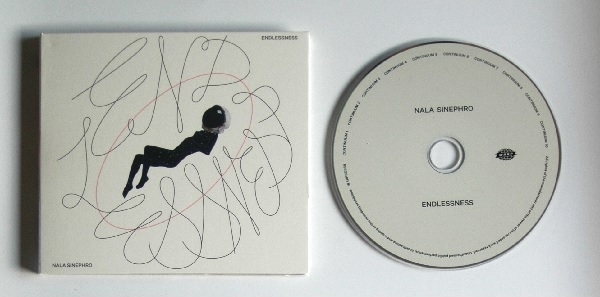
I loved Nala Sinephro’s debut album Space 1.8 (and wrote a little about it on my previous blog), so I was very much looking forward to hearing its follow-up: Endlessness. My CD copy, pre-ordered from Bandcamp, arrived in the post the day before last. I’ve properly listened to it only once so far, hence, while it delighted me, I can’t provide much more than some initial impressions of it.
One immediately feels in a similar sound-world as conjured up by Space 1.8, albeit with some additional elements. Foremost of those is the presence of a string section, which, when called upon, provides extra light & shade, foreground highlights & background textures. The ten tracks (titled ‘Continuum 1’ to ‘Continuum 10’) all apparently revolve around the same repeated arpeggio, presented in various guises as the album progresses, providing a connecting thread to the record as a whole.
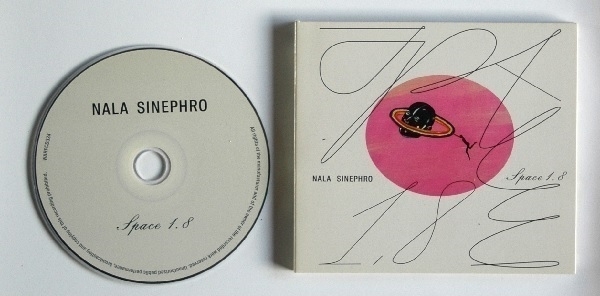
Some of the supporting musicians (such as Nubya Garcia & James Mollison) also lent contributions to the first album; while others (e.g. Sheila Maurice-Grey & Morgan Simpson) are new faces. All have combined their efforts to make music that speaks softly but seriously, and in a manner that compels attention. Their playing variously complements and counteracts the orderly progression of the synthesizer parts. There are a some moments when what I perceive as voice-like sounds (which could be actual voices or synthesized approximations) float just under the surface of the mix to highly intriguing effect.
It’s soft-edged, but not merely soothing; coherent without being unduly repetitive; and, in a word, fascinating. I’ll be getting to know it much better!
Mochi
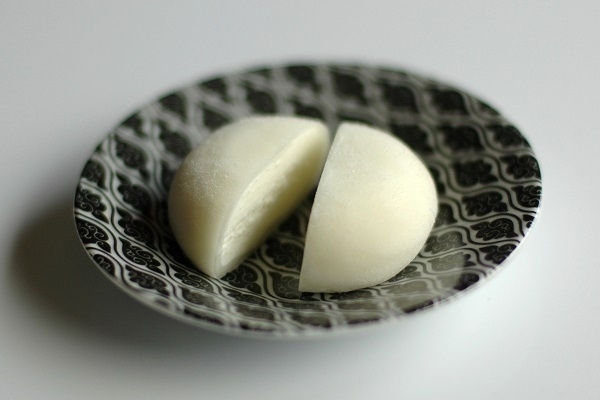
Something of a novelty in the supermarkets hereabouts: mochi ice-cream. According to Wikipedia “Mochi ice cream gained huge popularity in the UK following a viral TikTok trend, which began in January 2021”. That fact that I’ve only begun to notice the things this year goes to demonstrate just how far removed from the virality loop I am. All I can do is add my belated approbation to the phenomenon: I do like them. The contrast in texture and temperature between the ‘shell’ and the ice-cream is pleasing; and the small unit size is ideal for me. The one pictured above contains coconut ice-cream, and came from the local Aldi.
Eisbergfreistadt
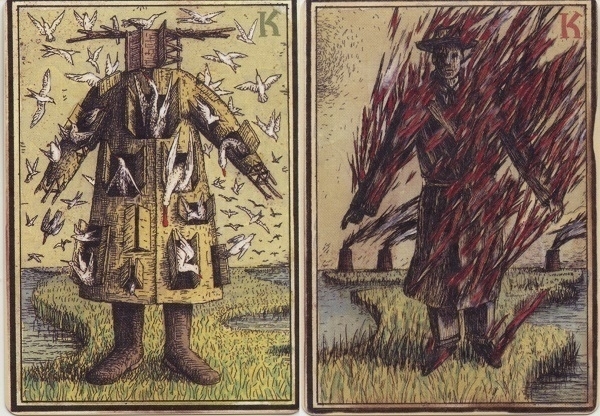
As well as some regular decks of playing cards, I also have a more unusual pack, one in which the four suits are birds, chimneys, icebergs and weeds. The ‘King’ cards from the former two suits are pictured above, those of the latter pair below. These were devised as part of an elaborate art project called Eisbergfreistadt realised in 2006-07 by the American artists Nicholas Kahn and Richard Selesnick. The conceit behind it was that of an iceberg drifting into the Baltic in 1923, running aground off the German port town of Lübeck, whereupon some of the the townspeople moved on to the ice, establishing a short-lived ‘free city’ there with its own laws and currency.
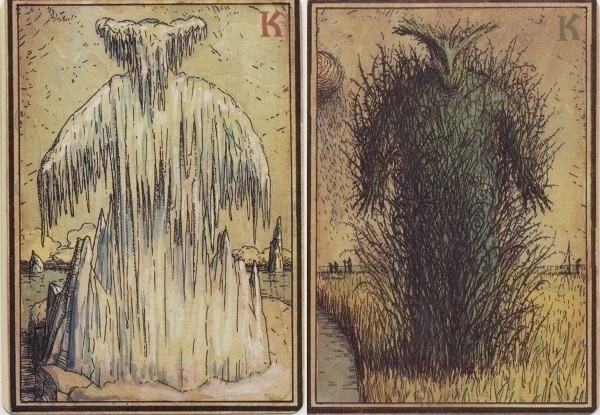
The ‘joker’ cards in the deck bear a rhyme alluding to this scenario, one of them in English, the other in German. Nicholas Kahn had contacted me in connection with my old weblog, and we had sporadically corresponded for a time after that. He very kindly sent me two packs of these cards (“one to use + one to give away” as he wrote in an accompanying note). There are some more images from the Eisbergfreistadt project here & here, and more images of the playing cards here.
Lincoln in the Bardo

When George Saunders' Lincoln in the Bardo was published in 2017 I skimmed through or glanced at a few very favourable reviews for it but was not tempted at that time to obtain a copy. I’m not sure it even registered with me when the novel won that year’s Man Booker Prize. Some years later, a friend enthused in a letter about Saunders' short story collection Tenth of December. While I didn’t act on that recommendation either, it did come back to mind when, late last year, I pulled a second-hand copy of Lincoln in the Bardo from a shelf at Broadleaf Books. As I was paying for it, the shop’s co-proprietor warmly praised the book, having lately read it himself with his book club. Even then, I didn’t read it right away.
The book, from the 7th printing of the UK hardback edition, was still somewhere in the middle of my ‘to be read’ pile at the time when I would have perused the listicle in which “The New York Times named it the 18th-best book of the 21st century”, which, again, failed to induce me to open it. Then, last month, while reading Giuseppe di Lampedusa’s The Leopard and feeling not quite in the right mood for its leisurely pace, I wandered over to the to pile in which Lincoln in the Bardo had been languishing and picked it up. On the back of its jacket were snippets from reviews I’d skimmed though or glanced at. Printed on the front so as to resemble a sticker (that I kept wanting to peel off), was mention of its Man Booker Prize win.
I finished it the day before yesterday. My estimation isn’t so very far from that of The New York Times: it’s somewhere up there among the most inventive, interesting and affecting novels I’ve read in recent decades. Unlike them, it wouldn’t occur to me to try to give it a numerical ranking. I thought it a story with many virtues and few flaws. It did strike me as a little baggy in places, and could perhaps have been edited down and tightened up just a smidgeon. I don’t think any summarisation of mine could do the book justice. I’d just suggest that if you happen to see a copy on a shelf somewhere (and you’ve not already read it), then pick it up, have a look, and see what you think.
Subjektiv
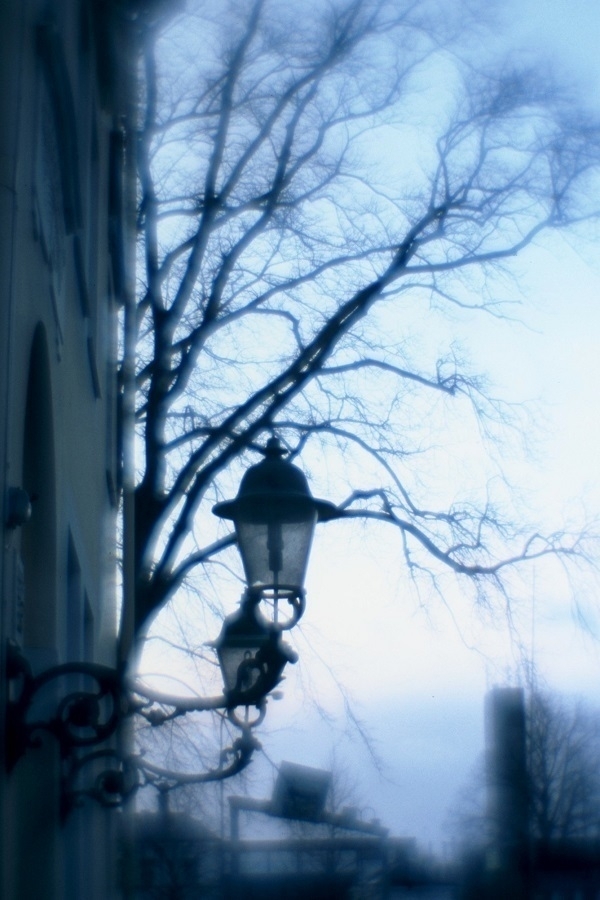
The photos here were taken with something called the ‘Monochrom Subjektiv’. This was a kind of kit comprising a piece in the shape of a 35mm camera lens into which one would fit interchangeable elements for use in achieving specific photographic effects. Those elements included a pinhole, a ‘zone plate’, and a plastic lens. The last of these was used for these images, lending them a dreamily soft-focus quality. Monochrom, I believe, was the brand-name, and Subjektiv the name of the product: a play on words as objektiv is the German term for a camera lens.
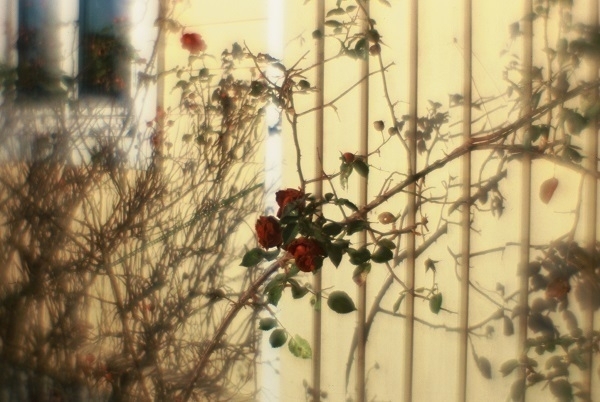
The Subjektiv was in this case attached to a Nikon F80 camera loaded with Fuji Astia 100F film. The pictures were taken in the autumn of 2008 in the Swedish town of Karlskrona.